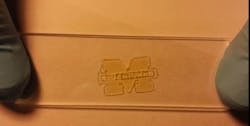Back in the age of dinosaurs when I was an engineering undergrad, the lab work generally ranged between uninspiring and discouraging.
One incident in particular comes to mind. It was in my freshman Introduction to Engineering class. We went out to a test lab where we ran tests on an internal combustion engine equipped with one of the early prototype catalytic converters -- these were the days before converters were standard equipment on vehicles. The experience was supposed to introduce us to a real-world engineering situation. We were then to write up the results in a formal engineering report as might be done for an actual industrial test.
But some joker in a class before us had dumped raw gas into the catalytic converter, pretty much killing any catalytic action. We spent 12 hours one Saturday desperately trying to coax any reaction at all out of the thing.
Fast forward to modern times. It seems like kids in STEM classes get to work on projects that far out-shine the "real world" stuff we were exposed to.
For example, consider a project at Johns Hopkins University where undergraduates invented an injectable foam system designed to stop profuse bleeding from a wound where a limb or the head is connected to the torso. Students there first conducted experiments with a gel that mimics the consistency of human tissue and used a rod to create “blood vessels” filled with water within the gel. Team members then carved “wounds” into the gel to simulate the bleeding process. To stop blood loss, the students combined polyol and a diisocyanate that rapidly form a polyurethane foam which hardens and applies pressure to the walls of the cavity. On the battlefield, the soldier administering the treatment would mix the two chemicals with a mechanism inside an injector. Then, pushing down the plunger would insert the expanding foam into the wound to reduce bleeding.
Also interesting are the entries in a student competition designed to explore the advantages of ultraviolet materials technology. Run by RadTech, a nonprofit Association for Ultraviolet (UV) and Electron Beam technologies, the competition got entries from kids that included one from University of Michigan undergrads who looked at thiolene materials, basically stuff that can function as an adhesive but which can, among other things, be patterned using UV.The project has spanned multiple groups over the years. This year's group added a honeycombed substrate that solidifies the catalyst. Originally, the catalyst was in a powder form and was prone to blowing out when the lawnmower was used.
Coming up with a potentially marketable device for emissions is certainly a long way from the busted catalytic converter we had to work with as undergrads.
About the Author
Lee Teschler
Editor
Leland was Editor-in-Chief of Machine Design. He has 34 years of Service and holds a B.S. Engineering from the University of Michigan, a B.S. Electrical Engineering from the University of Michigan;, and a MBA from Cleveland State University. Prior to joining Penton, Lee worked as a Communications design engineer for the U.S. Government.


